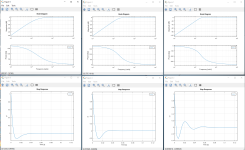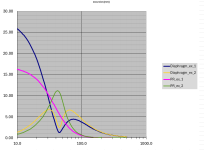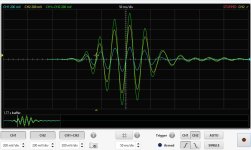Played around with Octave a bit more, denormalized the transfer function and have this plot, for Q=0.5, Q=0.7 and for a B4, all with approximate resonance frequencies of 30Hz. The Step response functions now show a settling time in seconds. The Vented box basically has 30Hz ringing superimposed on the step, which is going to be inaudible. You might hear it if the tuning frequency were 80 Hz, but even that is iffy.
Attachments
Just thinking a little about it.
- Band-reject filter: A filter designed to attenuate a specific range of frequencies.
- Band-reject slope: The steepness of the sides of the notch created by the band-reject filter.
- Bandwidth: The range of frequencies that a filter passes without significant attenuation. A high Q value corresponds to a narrower bandwidth, while a lower Q value corresponds to a wider bandwidth.
- Q: A measure of a filter's selectivity or bandwidth.
- Slope order: A measure of how steeply a filter's gain decreases as the frequency increases beyond the cutoff frequency. A steeper slope order indicates a more rapid attenuation of high frequencies.
what ever one does bigger system will work better,
imagine thinking a speaker that rolls off at 80hz isn't lacking bass....When they are positioned correctly on my desk there is no lack of bass just seems very controlled and precise.
@Nico Ras,
Ls3 sound different to other loudspeakers you own because... they are different: you can't really compare bass reflex, TL and sealed as is.
First their fc is different, Qtc is too but imho it's the steepness of slope which make them really different: 24db/oct for BR, 18db/octave for TL and 12db/octave for sealed.
With fc those are the 2 most 'audible' differences. Q have an effect but it's way more subtle.
How are your other loudspeakers set up in your room? It'll have a great effect on rendering too, which make comparison difficult ( unfair?) either.
If you find them to have less listening fatigue it's probably because you use them in the same scenario as they were planed to be used ( nearfield with boundary reinforcement). Fast and punchy because sealed (often described as punchy, but i prefer say with better time domain behavior) and with a relatively high fc with low steepness ( fast). And the amp you use is probably well matched to them.
Try to push them and listen at 2meters or more and let's see if you won't have listening fatigue ( Audax aerogel tweeter -edit: it was a kef tweeter on original, i only heard 'clones' with audax tweet- is nice but does have limits).
Overall the ls3/5 are well engineered loudspeakers and a kind of benchmark in nearfield monitors history. BBC engineers known what they were doing at that time. And if you take a look at what was used as nearfields until mid 90's you'll see the most ot them were sealed ( Auratone, Ns-10) with highish fc. The thing about it is time domain accuracy.
If you want to dig further about this you can read this about the ns-10 where it's well explained including the need for boundary reinforcement and what it does imho:
https://www.soundonsound.com/reviews/yamaha-ns10-story
Ls3 sound different to other loudspeakers you own because... they are different: you can't really compare bass reflex, TL and sealed as is.
First their fc is different, Qtc is too but imho it's the steepness of slope which make them really different: 24db/oct for BR, 18db/octave for TL and 12db/octave for sealed.
With fc those are the 2 most 'audible' differences. Q have an effect but it's way more subtle.
How are your other loudspeakers set up in your room? It'll have a great effect on rendering too, which make comparison difficult ( unfair?) either.
If you find them to have less listening fatigue it's probably because you use them in the same scenario as they were planed to be used ( nearfield with boundary reinforcement). Fast and punchy because sealed (often described as punchy, but i prefer say with better time domain behavior) and with a relatively high fc with low steepness ( fast). And the amp you use is probably well matched to them.
Try to push them and listen at 2meters or more and let's see if you won't have listening fatigue ( Audax aerogel tweeter -edit: it was a kef tweeter on original, i only heard 'clones' with audax tweet- is nice but does have limits).
Overall the ls3/5 are well engineered loudspeakers and a kind of benchmark in nearfield monitors history. BBC engineers known what they were doing at that time. And if you take a look at what was used as nearfields until mid 90's you'll see the most ot them were sealed ( Auratone, Ns-10) with highish fc. The thing about it is time domain accuracy.
If you want to dig further about this you can read this about the ns-10 where it's well explained including the need for boundary reinforcement and what it does imho:
https://www.soundonsound.com/reviews/yamaha-ns10-story
Last edited:
I don't have the space I had five years ago, so the bigger ones now live in storage.The LS 3/5a are original KEF T27 and B110 with the trace of glue around the dust cap to increase the mass. I listen to them without the grills because my HF is rolling off at 70. That years not Hz
I've done a quick simulation in VituixCAD of a vented-box loudspeaker system, which was tuned to Fb=60Hz and provided a f3 of 73.4Hz. I then used Keele's method to de-tune the enclosure to Fb=40Hz, while applying a 2nd-order high-pass filter with Q=2 (+6dB peak) set to 55Hz.The Keele 6th order alignment uses a 2nd order electronic high pass which while helpful is not steep enough to minimize excursion immediately below Fb.
The plot below shows the large improvement in low-frequency extension produced using Keele's method.
The high-pass filter significantly reduces the woofer displacement below the cut-off frequency of the high-pass filtered system. VituixCAD computes the displacement response curves for both systems, and the results are shown below. Keele's approach works very well, as the second-order high-pass filter seems steep enough to provide excellent protection against excessive driver displacement at very low frequencies.
Yes Keele's method is effective. I've used it on pa sub as purposed by DJK ( RIP), it helped to gain some bandwidth and output for Drum&Bass dj sets where protection was not superfluous.
It could be interesting to compare it to Perry's own method.
It could be interesting to compare it to Perry's own method.
In the 6th order space, you can usually play around and find a combination of filter and tuning that results in an excursion plot that results in roughly equal excursion peaks above and below tuning and a reasonably good extension of bass response.
For your 12HP1030 Keeles paper suggests a Vb of 13.1L and a Fb of 45Hz. Excursion plot looks like this at ~63 peak volts input.
For your 12HP1030 Keeles paper suggests a Vb of 13.1L and a Fb of 45Hz. Excursion plot looks like this at ~63 peak volts input.
Attachments
I have used VituixCAD to implement a filter-assisted low-frequency vented-box alignment using Perry's method. The acoustic frequency response is shown below, compared to that of the original vented-box tuning. The filter-assisted f3 of this system is f3=58.2Hz. This is not as low as what was achieved using Keele's approach.In the AX article I show a reflex tuned lower than normal so it has a soft knee, combined with a shelf filter with a Q of around 2. The combination is flat down to Fb and the shelf filter cuts the signal by about 20dB in 1/2 octave, then levels off. This reduces phase shift and the combination is quite elegant.
View attachment 1364622
The filter-assisted displacement response function was computed and is shown below. It has certainly significantly reduced the driver displacement below fb. However, that appears to have been obtained at the expense of a reduction in low-frequency extension of about 5Hz or so, which may or may not be an entirely desirable trade-off.
The high-pass shelf filter parameters that were used were: −16dB, f0=23.5Hz, Q=2.0, n=2. The computed filter gain function is shown below, and it is similar to the one sketched by Perry.
Of course, if we choose a different filter-assisted tuning, we can achieve a lower cut-off frequency. Here the high-pass shelf filter parameters were adjusted to be: −16.5dB, f0=20.9Hz, Q=2.5, n=2.
Last edited:
I would say that this IS a case of rectangular bass (or better: drums). But it has been high-pass filtered after the clipping was applied. Therefore the "sloping roofs".Thanks for suggesting that track. It's informative and it does introduce some distortion-like effects onto the drum kicks. These drum kicks have a fundamental peak occurring at around 45Hz. Although the drums do sound "dirty", they don't appear to be clipping as such.
Below is a typical waveform taken from that track. It's not quite in the territory of "square bass" as far as I can tell, and maybe it's more in keeping with "triangular bass".
View attachment 1363969
And the results of a frequency analysis of the track are shown below.
Sorry for off-topic.
Regards
Charles
The human ear cannot hear 10 Hz (for most people), but the body can sense this frequency. So Q would be audibly irrelevant.The response on the left has a Q 0.5 and a f3 of 10hz the response on the right has a Q of 18 and f3 of about 1200hz.... which one do you think sounds thin in application?
Now, 1200 Hz is a high frequency, which by its nature sounds thin and like a whistle. So, Q 18 at 1200 Hz would sound light and thin because of the frequency, but because of the high Q it would also sound: shrill, resonant and slow.
Really, I think that what people who say that "thin bass" comes from the low Q factor, are trying to express is that because the Q is low and the F3 is not very low (30<), the system, speaker, has less resonances because the stored energy is lost faster, which makes them think that it sounds "thin" because the system is less resonant.
Last edited:
I think that its purely the high F3 and no Q will save you.I think that what people who say that "thin bass" comes from the low Q factor, are trying to express is that because the Q is low and the F3 is not very low (30<)
Below is the simulated response to a 2.50-cycle 60-Hz toneburst with a cosine window applied when passed through a 4th-order Butterworth high-pass filter with –3dB cut-off at 27Hz. This result seems to be quite different to the one that was measured during the experiments.
Hi witwald, sorry it took so long to get back. I kept thinking of experiments to try, to get a better grip on burst measurements.
To dig in, i used the old basic sealed vs ported comparison, using the same driver, as I have some empty boxes for both, and some spare 18"s.
First thing I tried to measure is how well 4.5 cycle cosine bursts matched REW's electrical stimulus, with and without processing in place.
Processing being, response flattening down to the low end roll-off; and a low-pass filter at 100Hz. No hpf's used.
The sealed box had shelving added to flatten response to 30Hz. And the ported box had flattening down to its f-3 tuning at 31Hz.
For both sealed and ported, where response was naturally flat before processing, it made no difference.
Which makes sense to me....it's just a single freq tone burst.
However, once roll-offs initiated, both type boxes, whether raw or processed, stated showing bursts with envelope skewing.
Processed flattening took the envelope distortion away down to the frequency where response remained flat...which also makes sense i think.
Here is the sealed bursts at 40Hz and at 31.5Hz.
Notice the waveforms look close to the same, with 5 positive peaks and 4 negative, as expected for a 4.5 cycle burst.
A little envelope skewing has begun on the 31.5Hz, as the sealed's magnitude response is at the edge of rolling off. Along with a mild extra negative overring.
Here's the ported bursts at 40Hz and 31.5Hz.
The 40Hz has a little more post-burst ripple compared to sealed, but otherwise very close. I'd call them the same.
The 31.5Hz burst however, both inverts, and adds positive and negative peaks.
The port seems to lengthen the time of the burst.
I noticed the same burst-lengthening phenom earlier on the large ported dual 18" (in the pict above backgound)
Which is why I wanted a direct comparison to sealed.
Until now, I've hadn't encountered a sealed vs ported measurement, that once mag and phase response were truly equal, made me think there was any difference between how the two will sound or measure.
Now I'm wondering....
Did you measured the speakers as the picture shows (mic is close to dustcap)? If so, then maybe the ports didn't summed properly with the woofer at the position of the mic in the case of the vented box.To dig in, i used the old basic sealed vs ported comparison, using the same driver
Thanks for the test!Processing being, response flattening down to the low end roll-off; and a low-pass filter at 100Hz. No hpf's used.
The sealed box had shelving added to flatten response to 30Hz. And the ported box had flattening down to its f-3 tuning at 31Hz.
Did that EQ result in an approximate -24dB per octave roll-off below 30Hz for both the sealed and ported box?
The amplitude of the ported enclosure is less than that of the sealed in both charts, but the relative difference more evident on the 31.5Hz burst due to the port's output contribution being greater at Fb than at 1/3 octave above, where the cone's excursion would be greater.The 31.5Hz burst however, both inverts, and adds positive and negative peaks.
The port seems to lengthen the time of the burst.
Seems apparent the port's phase inversion lag adds a cycle to the burst, apparent even with the mic position favoring the cone output over the ports.Until now, I've hadn't encountered a sealed vs ported measurement, that once mag and phase response were truly equal, made me think there was any difference between how the two will sound or measure.
Now I'm wondering....
Art
Did you measured the speakers as the picture shows (mic is close to dustcap)? If so, then maybe the ports didn't summed properly with the woofer at the position of the mic in the case of the vented box.
Hi YSDR, yep I was concerned with a mic in only one of the four corner ports, and one right at the dustcap.
Over the last few days of further burst experiments with that sub, and the larger dual 18" with its big single port,
it turns out those mic placements were indeed a problem on that single 18" ported.
When the port is providing all the output like at port tuning frequency or lower.
it appears that the port pushes back internally through the box, against the rear of the cone.
So I think the measured response from the mic at the cone's dust cap, was primarily the port moving the cone, and not the cone being driven by the amp.
and hi ART,
I now think the inversion I thought I was seeing below port tuning with the single !8", cone vs port, was bogus. That smaller sub with the internal port openings closer to the rear of the cone, behave a bit differntly than the large vtwin where the port opening is relatively much farther from the cones.
I positioned mics on the large vtwin sub as far from each other as possible, and made sure they are voltage matched.
Here's a new set of 4.5 cycle cosine bursts.
Yellow is Port, Blue is Cone, and Green is their Sum.
80Hz first.
51Hz, where port and cone have equal contibuting outputs.
Now 25Hz, which is 1-2Hz below impedance minima tuning,...... and both are still in phase
20Hz.... where I suspect port push-back on come, giving a small out-of-polarity blue cone trace
Notice the voltage scale change...not much output to even be measuring down there..
Anyway hope all that was clear.
Sorry for ongoing stumbling around. Still trying to get a fully definitive handle on bursts..
Attachments
Oh, forgot to answer.. yes, I think both had close to -24dB rolloff....but don't know for sure.Did that EQ result in an approximate -24dB per octave roll-off below 30Hz for both the sealed and ported box?
Impossible to accurately measure the 4-corner port sub indoors...it's a driveway only measurement for any kind of certainty.
Now the vtwin on the other hand....it doesn't care where it's measured... both driveway @ 4m ground plane, and 4" inches from sub indoors.... measure the same!!!.
Never had a ported sub so easy to measure.
- Home
- Loudspeakers
- Multi-Way
- Why is a critically damped Q factor bad?


